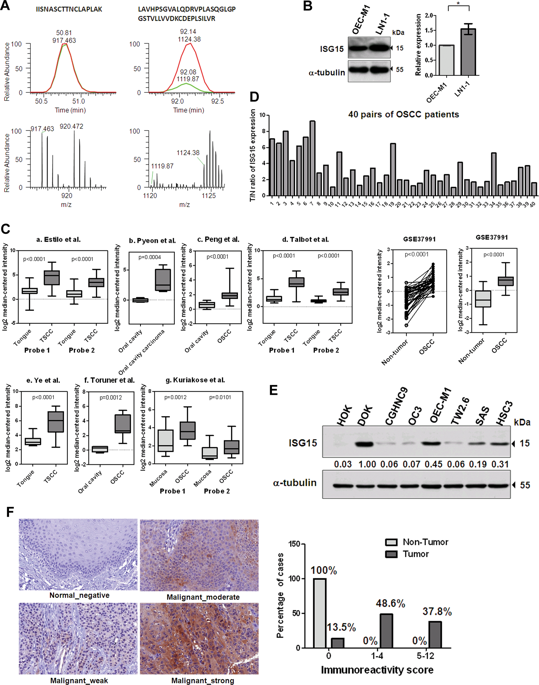Our official English website, www.x-mol.net, welcomes your feedback! (Note: you will need to create a separate account there.)
Interferon-stimulated gene 15 modulates cell migration by interacting with Rac1 and contributes to lymph node metastasis of oral squamous cell carcinoma cells.
Oncogene ( IF 8 ) Pub Date : 2019-02-14 , DOI: 10.1038/s41388-019-0731-8 Yu-Lin Chen , Wan-Lin Wu , Chuan-Wei Jang , Yi-Chen Yen , Ssu-Han Wang , Fang-Yu Tsai , Ying-Ying Shen , Ya-Wen Chen
Oncogene ( IF 8 ) Pub Date : 2019-02-14 , DOI: 10.1038/s41388-019-0731-8 Yu-Lin Chen , Wan-Lin Wu , Chuan-Wei Jang , Yi-Chen Yen , Ssu-Han Wang , Fang-Yu Tsai , Ying-Ying Shen , Ya-Wen Chen

|
In an effort to understand the underlying mechanisms of lymph node metastasis in oral squamous cell carcinoma (OSCC), through in vivo selection, LN1-1 cells were previously established from OEC-M1 cells and showed enhanced lymphangiogenesis and lymphatic metastasis capabilities. In the current study, we use a stable isotope labeling with amino acids in cell culture (SILAC) and liquid chromatography-tandem mass spectrometry (LC-MS/MS)-based proteomic platform to compare LN1-1 to OEC-M1 cells. Interferon-stimulated gene 15 (ISG15) was found highly expressed in LN1-1 cells. Immunohistochemical analysis and meta-analysis of publicly available microarray datasets revealed that the ISG15 level was increased in human OSCC tissues and associated with poor disease outcome. Knockdown of ISG15 had minimal effects on tumor growth but did decrease tumor lymphangiogenesis and lymphatic metastasis of LN1-1 cells. Consistent with the in vivo assay, ISG15 knockdown did not impair cell growth but diminished cell migration, invasion, and transendothelial migration in vitro. ISG15-induced cell migration was independent of ISGylation and associated with membrane protrusion. Ectopic expression of ISG15 increased Rac1 activity and knockdown of Rac1 impaired ISG15-enhanced migration. Furthermore, Rac1 colocalized with ISG15 to a region of membrane protrusion and ISG15 coimmunoprecipitated with Rac1, especially with the Rac1-GDP form. Importantly, as shown by proximity ligation assays, ISG15 and Rac1 physically interacted with each other. Our results indicated that ISG15 affects cell migration by interacting with Rac1 and regulating Rac1 activity and contributes to lymphatic metastasis in OSCC.
中文翻译:

干扰素刺激的基因15通过与Rac1相互作用来调节细胞迁移,并有助于口腔鳞状细胞癌细胞的淋巴结转移。
为了了解口腔鳞状细胞癌(OSCC)淋巴结转移的潜在机制,通过体内选择,先前从OEC-M1细胞建立了LN1-1细胞,并显示出增强的淋巴管生成和淋巴转移能力。在当前的研究中,我们在细胞培养(SILAC)和基于液相色谱-串联质谱(LC-MS / MS)的蛋白质组学平台上使用氨基酸进行稳定同位素标记,以比较LN1-1和OEC-M1细胞。发现干扰素刺激的基因15(ISG15)在LN1-1细胞中高表达。公开的微阵列数据集的免疫组织化学分析和荟萃分析显示,人OSCC组织中ISG15水平升高,且与疾病预后不良相关。剔除ISG15对肿瘤的生长影响很小,但确实减少了LN1-1细胞的肿瘤淋巴管生成和淋巴转移。与体内测定一致,ISG15敲低不损害细胞生长,但减少了体外细胞迁移,侵袭和跨内皮迁移。ISG15诱导的细胞迁移独立于ISGylation,并与膜突出相关。ISG15的异位表达增加了Rac1的活性,Rac1的敲低损害了ISG15增强的迁移。此外,Rac1与ISG15共定位到膜突出区域,而ISG15与Rac1共免疫沉淀,尤其是与Rac1-GDP形式共沉淀。重要的是,如邻近结扎分析所示,ISG15和Rac1彼此物理相互作用。
更新日期:2019-02-15
中文翻译:

干扰素刺激的基因15通过与Rac1相互作用来调节细胞迁移,并有助于口腔鳞状细胞癌细胞的淋巴结转移。
为了了解口腔鳞状细胞癌(OSCC)淋巴结转移的潜在机制,通过体内选择,先前从OEC-M1细胞建立了LN1-1细胞,并显示出增强的淋巴管生成和淋巴转移能力。在当前的研究中,我们在细胞培养(SILAC)和基于液相色谱-串联质谱(LC-MS / MS)的蛋白质组学平台上使用氨基酸进行稳定同位素标记,以比较LN1-1和OEC-M1细胞。发现干扰素刺激的基因15(ISG15)在LN1-1细胞中高表达。公开的微阵列数据集的免疫组织化学分析和荟萃分析显示,人OSCC组织中ISG15水平升高,且与疾病预后不良相关。剔除ISG15对肿瘤的生长影响很小,但确实减少了LN1-1细胞的肿瘤淋巴管生成和淋巴转移。与体内测定一致,ISG15敲低不损害细胞生长,但减少了体外细胞迁移,侵袭和跨内皮迁移。ISG15诱导的细胞迁移独立于ISGylation,并与膜突出相关。ISG15的异位表达增加了Rac1的活性,Rac1的敲低损害了ISG15增强的迁移。此外,Rac1与ISG15共定位到膜突出区域,而ISG15与Rac1共免疫沉淀,尤其是与Rac1-GDP形式共沉淀。重要的是,如邻近结扎分析所示,ISG15和Rac1彼此物理相互作用。

























 京公网安备 11010802027423号
京公网安备 11010802027423号